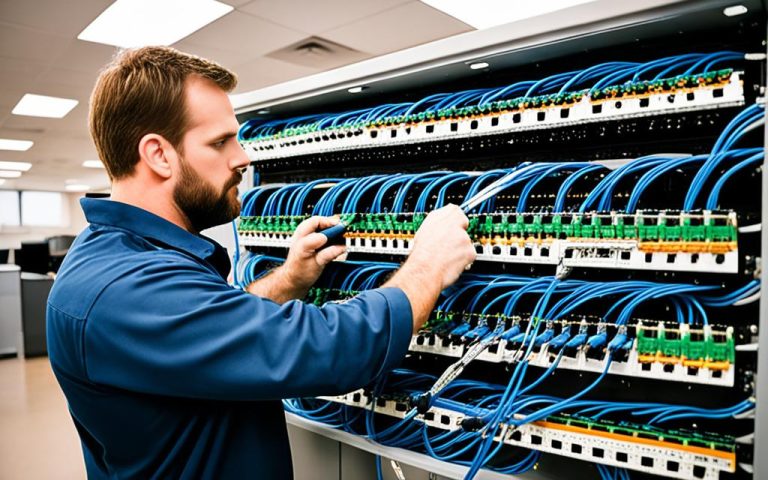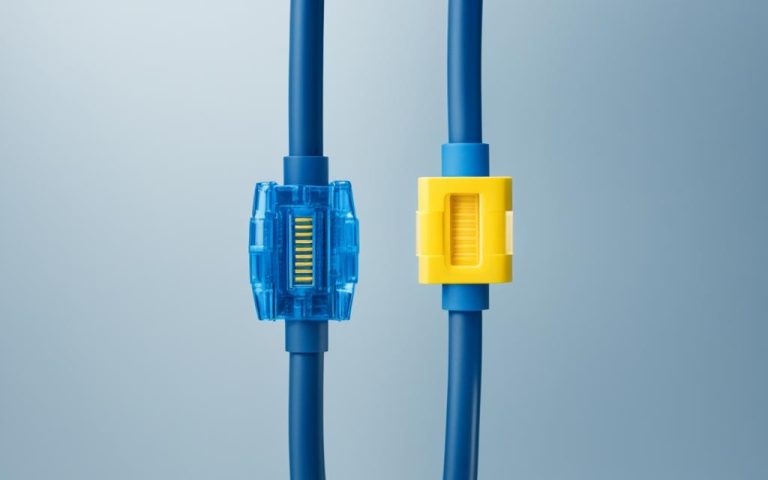A backhaul network is key to wireless systems, making sure they work well over long distances. It connects the main networks to smaller ones, making sure data moves fast and reliably.
Wireless systems use backhaul networks to send data, voice, and video signals far away. This connects remote places to the internet. Backhaul networks are vital for many uses, from big data centers to city-wide networks. They’re also crucial for 5G networks.
Backhaul networks are very important in wireless systems. ABI Research says they will make up about 65% of the global backhaul by 20271. They offer many benefits like being easy to set up, flexible, and able to handle more traffic. They also cost less to run than wire or fiber backhaul1.
Backhaul networks support important tasks in different areas. In data centers, they focus on being reliable and stable for sending data, videos, and voice calls1. In city networks, they help create fast Wi-Fi without the need for cables in homes and businesses1. They also help set up wireless internet in both work and home areas with wireless mesh systems1.
- Wireless backhaul is a critical component of wireless systems, providing essential connectivity for extending network coverage and enabling a seamless digital experience.
- It is projected that wireless backhaul will comprise around 65% of the global backhaul by 2027, according to ABI Research1.
- Wireless backhaul applications in data centers prioritize reliability and connection stability, facilitating efficient data, video, and voice throughput1.
- The use of wireless backhaul in metropolitan area networks (MANs) enables high-bandwidth Wi-Fi coverage in urban areas without physical cabling1.
- Wireless mesh systems utilizing wireless backhaul provide multiple access points for wireless internet connectivity within commercial and residential areas1.
- Integrating wireless backhaul into 5G architecture is crucial for expanding broadband connectivity for mobile operators, private enterprises, and customers1.
- Advantages of wireless backhaul include scalable deployment options, adaptive systems, and reduced operating costs compared to wire and fiber backhaul alternatives1.
What is Backhaul?
Backhaul is key to letting data move from cell sites to the internet. It’s a big part of how telecom networks work. It connects the main network to the outer parts, letting users get online easily. Backhaul uses either wires or wireless, based on what’s needed and what’s there.
In wireless networks, backhaul is crucial for sending data between cell sites and the main network. This is key for a good internet connection. As wireless tech gets better, it’s taking over from old cable systems, offering more flexibility.
By 2027, about 65% of backhaul will be wireless, says1. This shows wireless backhaul is becoming a big deal in telecom.
With 5G, backhaul is more important than ever. 5G can use wires, fiber, or wireless for backhaul. This gives many ways to boost broadband for mobile and business networks.
Backhaul isn’t just for telecom. It’s also key for linking data centers with remote offices, making data sharing smooth. It helps keep surveillance networks safe by ensuring steady video streams.
Wireless mesh networks use backhaul too. They give many ways to connect to the internet at home or in businesses. This makes wireless networks better and more accessible.
Wireless backhaul is a great choice over old wire and fiber systems. It’s flexible, efficient, and works well in many places. This makes it a top tech for our connected world.
| Key Benefits of Wireless Backhaul |
|---|
| Scalability and flexibility |
| Reliable connections in different locations |
| Cost-effective alternative to wired backhaul |
| Enhanced coverage and accessibility with wireless mesh networks |
How Does Backhaul Work?
Backhaul is key to wireless networks, linking the access, primary, and core networks for smooth data transfer. Let’s dive into how it works and the tech behind it.
The backhaul network connects the core and access networks, letting data move efficiently. It’s vital for keeping communication smooth. The choice of backhaul tech depends on the network’s setup and tech.
- Fiber-based backhaul and wireless point-to-point backhaul are top choices for mobile networks to link cell towers to the core2.
- Copper-based wireline, satellite communications, and point-to-multipoint wireless technologies are fading out in 4G LTE and 5G for needing more capacity and lower latency23.
- Wired backhaul uses copper line backhaul, dark fiber backhaul, and Ethernet backhaul, with fiber taking over copper lines mostly2.
- Wireless backhaul reaches rural areas, using microwave technology over wireless spectrum23.
- Satellite backhaul serves remote areas and sometimes as a backup, offering 150 Mbps downlink and 10 Mbps uplink but with high latency2.
- Wi-Fi backhaul connects through small cells or femtocells in homes, making networks denser and boosting coverage and capacity2.
The diagram shows how backhaul data flows, linking the wireless network’s parts. It underlines backhaul’s role in efficient data transfer between the access, primary, and core networks.
As wireless tech evolves and demands for speed and reliability grow, backhaul’s importance in network operations is clear. Understanding backhaul and its tech helps us see its complexity and value.
| Advantages of Backhaul | Wireless Backhaul | Wired Backhaul |
|---|---|---|
| Cost-efficient | ✓ | ✗ |
| High capacity connectivity | ✓ | ✓ |
| Quick deployment | ✓ | ✗ |
| Reduced infrastructure costs | ✓ | ✗ |
| Reliable and secure | ✓ | ✓ |
The table shows wireless and wired backhaul’s perks. Wireless is great for saving costs, high capacity, fast setup, and cutting infrastructure costs. Wired backhaul is dependable, secure, and supports high-bandwidth needs34.
Critical Applications of Backhaul
Backhaul networks are key to the modern mobile network, making sure devices and base stations talk to each other smoothly. They use fiber and wireless links to move data fast and efficiently. This keeps mobile networks running well.
As more people use mobile devices, the need for good backhaul has grown. In 2008, about 1.3 exabytes of data moved through wireless networks. By 2013, this jumped to 1.6 exabytes a month5.
Backhaul is important for mobile network performance and costs a lot. In fact, 30% of what networks spend goes on backhaul5.
Most base stations now use wireless links for backhaul, making it easier to expand networks5. This wireless method is flexible and quick to set up.
Backhaul keeps mobile services running smoothly, even in tough times. During Hurricane Sandy, many networks failed, but backhaul systems kept the Internet mostly up5.
Fiber cables are a big part of backhaul, offering the speed and reliability needed. They’re expected to keep playing a big role in the future5.
In rural areas, wireless backhaul is key for fast internet access. It’s vital for reaching places where laying cables isn’t possible or too expensive6.
Thanks to wireless backhaul, rural folks can enjoy things like online info, health services, banking, learning, and IoT apps. FiberLight’s work in rural areas shows how important this is6.
Smartphones are getting more popular and use more data. By 2018, over half of devices will be smartphones, and this number will keep rising7. This means more data will be used, especially for streaming videos.
To handle this, mobile backhaul networks will need to get better. They’ll need more capacity to support all the users and their data needs7.
There are different ways to set up mobile backhaul networks, like ring, hub and spoke, and daisy chain7. New tech like NFV and SDN will help make these networks better and more flexible7.
Summary Table: Statistical Data on Backhaul
| Statistical Data | Source |
|---|---|
| Approximately 1.3 exabytes of data were transferred among wireless mobile devices in 2008. | 5 |
| By the end of 2013, the monthly mobile data transferred was estimated to reach 1.6 exabytes. | 5 |
| 30% of operating costs for cellular networks are allocated to backhaul expenses. | 5 |
| Backhaul equipment revenue is projected to reach $1 billion by 2017. | 5 |
| 70% of base stations utilize a wireless link for backhaul to the Internet. | 5 |
| Wireless demand is increasing at a rate of 20 times faster than the demand for fixed wire-line services. | 5 |
| Over $300,000 in OPEX can be incurred over five years for fiber and cable backhaul links. | 5 |
| Fiber cables play a crucial role in providing core network infrastructure. | 5 |
| Less than one minute of outage occurred in the entire year for the core Internet due to redundant links. | 5 |
| Hurricane Sandy caused at least 20% of the cellular network to go offline, leading to service outages. | 5 |
| Wireless backhaul is crucial for providing high-bandwidth connectivity in remote or rural areas where physical cabling is not feasible or cost-prohibitive. | 6 |
| The growing demand for high-bandwidth connectivity in rural America is being driven by applications like streaming content and the need for reliable, low-cost, high-speed Internet access. | 6 |
| Rural communities now have access to important resources such as public sector information, telehealth, online banking, distance learning, and IoT applications due to advancements in connectivity. | 6 |
| FiberLight has more than 17,000 fiber route miles in remote regions of the United States, highlighting their expertise in wireless backhaul infrastructure. | 6 |
| By 2018, research indicates that data-hungry smartphones will grow from just over 50 percent of all devices to almost 70 percent. | 7 |
| Bandwidth consumption by smartphone-equipped mobile users continues to rise due to high-bandwidth, video-centric content consumption. | 7 |
| MBH bandwidth is projected to surpass the typical 1 Gb/s to a macro tower due to trends like more users, higher bandwidth per user, longer content viewing times, and the popularity of higher resolution videos. | 7 |
| MBH networks offer three main network topologies: ring, hub and spoke, and daisy chain. | 7 |
| Network Functions Virtualization (NFV) and Software-Defined Networking (SDN) technologies and services are anticipated to play a significant role in how MBH networks will adapt and evolve. | 7 |
Key Types of Backhaul
There are many backhaul network options, each fitting different needs and situations. These options fall into two main categories: wired and wireless backhaul solutions.
Wired backhaul uses cables or fiber networks for data transfer. It ensures reliable and fast connections. Here are some key wired backhaul types:
- Copper line backhaul: This method uses twisted-pair or coaxial cables. It’s chosen when cost is a big factor8.
- Dark fiber backhaul: Dark fiber means unused optical fibers rented for network connections. It offers high capacity and quick data transfer8.
- Ethernet backhaul: Ethernet backhaul uses Ethernet tech for fast and expandable data transfer9.
Wireless backhaul uses microwaves or radio waves for data transfer between access points. It’s good when fiber setup isn’t possible9. Here are some wireless backhaul types:
- Wireless backhaul: Wireless backhaul includes Microwave (MW), millimeter wave (mmW), point-to-multipoint (PtMP), and point-to-point (PtP) connections9.
- Satellite backhaul: Satellite backhaul connects remote areas or acts as a temporary fix8. It has higher latency but is useful in tough spots8.
- Wi-Fi backhaul: Wi-Fi backhaul uses Wi-Fi for connectivity. It’s a top pick for wireless access points8.
Each backhaul type has its pros and cons. Companies must pick the best one for their needs. Leading brands like Cambium Networks, Ubiquiti, TP-Link, and others offer top-notch backhaul devices9.
| Backhaul Type | Advantages |
|---|---|
| Wired Backhaul | – Reliable and high-speed connectivity – Scalable and future-proof – Suitable for large-scale deployments |
| Wireless Backhaul | – Flexibility and ease of deployment – Ideal for areas without wired infrastructure – Cost-effective for small to medium-scale deployments |
Wireless Backhaul Applications
Wireless backhaul is changing how we connect, used in many areas. It’s a flexible and efficient way to replace old wired systems. It’s key in making sure data centers and surveillance networks work well.
Data Centers and Remote Offices
Wireless backhaul links data centers with remote offices, making sure they work smoothly and securely. This is crucial for businesses to move lots of data fast and keep in touch across different places1.
Surveillance Networks and Last-Mile Aggregation
Surveillance networks need strong and safe connections to get video footage in real-time. Wireless backhaul makes these connections better, improving how data gets to monitoring centers without losing signal1.
5G Networking
Wireless backhaul is key to 5G networks. As we need faster and more reliable connections, it supports the growth of broadband in mobile and business networks1.
Rural Connectivity and Broadband Expansion
In rural areas, wireless backhaul is crucial for connecting remote places. The need for fast internet in rural America is growing, for things like streaming, telehealth, and online learning6. Money is being spent to bring the Internet to rural areas for more than just fun6. Fast internet is changing rural life, making things like smart farming and monitoring animals possible6. But, getting internet to rural areas is hard because of the lack of cables and needing a fiber link to the data centers6. Small ISPs in rural areas have to cover big areas, needing towers far apart to reach fiber networks6. FiberLight, a big provider, has a huge network in rural parts of the US, showing their wide reach6.
Wireless backhaul keeps getting better, meeting our need for fast and reliable connections. It can handle lots of data streams, making sure data, video, and voice move smoothly1. New wireless backhaul types are making the internet even more accessible worldwide1.
“Wireless backhaul enables the reliable and high-bandwidth connections necessary for seamless data transfer and communication in various industries.” – ABI Research1
What is Wireless Mesh?
Wireless mesh networks use wireless backhaul to create many access points for smooth internet in different places. These access points make a mesh network, spreading wireless coverage in homes, schools, or offices. They don’t need wired connections like old systems, offering less delay and reliable internet in various settings.
Many affordable mesh systems use a shared Wi-Fi backhaul, working with both the 2.4GHz and 5GHz bands10. But, as mesh systems get better, they often use dedicated backhauls. This means one band is just for backhaul, making the network work better10.
Mesh systems can also use a wired Ethernet backhaul, making the network more stable, cutting down on delays, and easing network congestion10. Also, tri-band routers can use the extra 5GHz band for devices connected by Ethernet. This makes the network work as well as tri-band setups10.
In wireless mesh networks, each access point sends and receives data. This lets data move directly between nodes, cutting down on the need for a single central point. So, wireless mesh networks give secure and fast internet links for businesses and homes1.
Wireless mesh networks are great when wired connections aren’t possible or cost too much. They offer a flexible and scalable way to set up networks, making them quick to deploy and cheaper to run than fiber or leased lines1.
What is Microwave Backhaul?
Microwave wireless backhaul is key to wireless networks, offering fast data transfer, low delay, and dependable connections. It’s a budget-friendly option compared to fiber optics in tough spots.
Thanks to new tech, microwave backhaul has gotten better, making it more efficient and flexible. These updates have boosted its capacity, made it more reliable, and cut costs11.
By using millimeter wave bands, microwave backhaul can send data over short distances at high speeds. It uses strong signals to increase capacity and support fast data transfer11.
Point-to-point microwave systems with special antennas work great for long distances in tough terrains. They ensure reliable connections, even over difficult landscapes11.
Line-of-sight microwave systems are also crucial in telecom. They provide steady long-distance service, making sure messages get through over long distances11.
Heinrich Hertz first showed radio waves in 1887, starting microwave technology. By 1931, microwaves were used for data across the English Channel11.
In the late 1940s and 1950s, microwave relay systems became more common. The introduction of digital microwave radio in 1976 changed the game11.
Adaptive modulation radio came out in 2008, letting microwave links change data rates with the weather. This made microwave backhaul even better11.
Comsearch is a top name in microwave training, offering courses and licensing. With years of microwave design know-how, they teach the latest in the field11.
Having a clear image of microwave backhaul in action helps show its role and tech in wireless networks.
Advantages of Wireless Backhaul
Wireless backhaul has many benefits that make it a top choice over wired options. It’s scalable, flexible, cost-effective, and quick to set up. These features make it great for companies around the world.
Scalable and Flexible
Wireless backhaul systems grow with your traffic needs1. They handle heavy data like video streaming and online gaming smoothly4. This means you can upgrade your network without spending a lot.
Cost-Effective
Wireless backhaul cuts down on costs by avoiding fiber or leased lines. It uses airwaves for connectivity, saving money on setup and maintenance4.
Quick Deployment
Wireless backhaul is fast and easy to set up4. It’s perfect for quick events or emergency situations because it doesn’t need cables4.
Siklu’s wireless tech can reach speeds of up to 10 Gbps in both directions12. This means businesses can handle lots of data without slowing down. Siklu also ensures reliable video streaming with no packet loss and little interference12.
With Siklu’s WiNDE design engines, companies can build strong wireless networks12. These networks work well for different needs, like performance or saving money12.
Wireless backhaul is a strong choice over wired options. It’s scalable, flexible, cost-effective, and quick to set up. This makes it ideal for building networks that keep up with today’s digital world.
Wireless Backhaul and 5G
Wireless backhaul is key for 5G networks. Before 5G, mobile operators had to set up the right transport tech. This tech supports the network’s needs for reliability, speed, and data handling. Wireless backhaul, along with other tech, gives the needed infrastructure for 5G’s wide range of services.
In smart cities, over 3 billion devices will connect by 202113. 5G will change backhaul networks by handling more data, cutting down on delays, and improving connections. This lets many devices connect at once, boosting IoT use14. A 5G device might use up to ten times more wireless capacity than 4G13. This means current backhaul networks won’t do, so new solutions are needed13.
5G backhaul uses a wide range of frequencies, especially millimeter waves (mmWave) from 24 GHz to 100 GHz14. Millimeter waves give fast data transfer, better security, and support for lots of devices in a small area14. Fiber backhaul can handle over 10 Gbps and has very low delay13. Choosing the right wireless backhaul tech is key for 5G’s performance.
ACiiST solutions are 90% cheaper and 70% easier to maintain than old tech13. This is great for operators and providers wanting to set up wireless backhaul on a big scale. A mix of wireless and wired backhaul might be needed for smart cities to support 5G’s needs13.
Wireless backhaul uses 4–11 GHz for long distances and 6–42 GHz for short distances with more channels15. Millimeter waves (mmW) above 57 GHz are a cost-effective way for fast connections over short distances15. E-band offers wide channels for high speeds with a single 2 GHz channel15. These wireless backhaul advances help operators meet 5G’s data demands.
To show how wireless backhaul helps 5G, consider ACiiST solutions. ACiiST turns streetlights into IoT hubs, making it easy to add smart devices without bothering people13. This method uses what’s already there, making it cheaper and easier to build out wireless backhaul in cities.
Wireless Backhaul and 5G Summary:
Wireless backhaul is vital for 5G networks. 5G’s higher data handling, lower delays, and better connections support IoT growth in areas like smart cities, manufacturing, and healthcare14. Affordable wireless backhaul options, like ACiiST, help operators meet 5G needs while saving money and using infrastructure well1315.
Wireless Backhaul Frequency Bands
| Frequency Band | Application |
|---|---|
| 4–11 GHz | Long-distance connectivity |
| 6–42 GHz | Short-term connectivity with wider channel availability |
| Millimeter Waves (mmW) Bands (above 57 GHz) | Ultra-high-speed connectivity over short ranges |
| E-band (62.5 MHz to 2000 MHz) | High throughput using a single 2 GHz channel |
Open Solutions: Using Many Connections as Backhaul
Open-source wireless mesh networks, like those using DD-WRT and OpenWRT firmware, offer flexible and scalable options. They use many connections as a backhaul for secure and fast internet access. This approach cuts down on the need for expensive cables and makes extending network coverage cheaper.
Wireless mesh networks are becoming more popular as wireless needs grow. They are made up of nodes that talk to each other, creating a strong network without needing a central router or cables. Each node works as both a client and a router, sending data to other nodes. This makes the network self-healing and decentralized.
Wireless mesh networks can grow easily as more devices and coverage areas are added. Using many connections as backhaul spreads out traffic and keeps connectivity strong, even in tough spots.
“The key advantage of using wireless mesh networks is their ability to provide seamless coverage and connectivity in a cost-effective manner.”
| Advantages of Open Solutions for Wireless Mesh Networks | |
|---|---|
| Scalability | Wireless mesh networks can easily scale to accommodate a growing number of devices and expanding coverage areas. |
| Cost Reduction | By using existing infrastructure and avoiding big cable projects, open-source wireless mesh networks are cheaper ways to extend coverage. |
| Flexibility | Open-source router firmware lets you customize and tweak network settings to fit your needs and improve performance. |
| Reliability | Wireless mesh networks can keep working even if a node fails or drops out, ensuring constant connectivity. |
| Speed and Performance | With multiple connections as backhaul, data moves fast and latency is low, making devices work better. |
| Open Standards and Interoperability | Open-source solutions follow IEEE 802.21 standards, making them work well with many devices and network gear. |
Open solutions for wireless mesh networks have many benefits for things like public Wi-Fi, smart cities, IoT, and rural internet. They make sure connectivity is smooth, allow for easy growth, and cut down on costs. This makes them a great choice for groups and communities wanting to grow their networks.
Thanks to open-source router firmware, IEEE 802.21 standards, and new tech, wireless mesh networks are changing how we connect and communicate. They offer scalable, affordable, and reliable ways to meet the growing need for wireless connections.
References:
Conclusion
Wireless backhaul networks are key to our digital world, connecting us all. They make sure our networks work well and reach out to smaller areas. Using copper, fiber, and wireless, they send data from far-off places to central spots, keeping our connections strong and smooth16.
In telecom, backhaul boosts network speed and capacity. Wired backhaul uses fiber cables for strong data transfer16. Wireless backhaul, like microwave and satellite, is cheaper and supports new services16. These techs are vital for fast wireless connections and future digital growth.
5G needs backhaul networks for fast data transfer17. As 5G spreads, investing in fiber will hit billions, showing backhaul’s key role17. 5G’s new tech brings challenges, but solutions like 100Gb/s Ethernet help overcome them17.
Backhaul networks are crucial for wireless systems. They ensure smooth connections, boost network performance, and support new apps and services. As tech advances, backhaul’s importance will grow1617. Investing in strong backhaul tech means a connected future for us all16.
FAQ
What is a backhaul network?
A backhaul network connects the core networks to smaller subnetworks in wireless systems. It’s key for extending network coverage and giving users internet access.
How does backhaul work?
Backhaul links the access network to the primary and core networks. It moves data packets between these networks. This connection is vital for internet access.
What are the critical applications of backhaul?
Backhaul is crucial in mobile networks, moving data between base stations and devices. It uses fiber and wireless to connect cell towers to the network.
What are the key types of backhaul?
Backhaul comes in wired and wireless forms. Wired uses cables or fiber for data transfer. Wireless uses microwave or radio waves.
Satellite backhaul is for remote areas, and Wi-Fi backhaul uses Wi-Fi technology.
How are wireless backhaul applications used?
Wireless backhaul is growing in use for its efficiency. It connects data centers to remote offices and supports surveillance networks.
It’s also key for 5G networks, expanding broadband in mobile and enterprise networks.
What is a wireless mesh network?
Wireless mesh networks use wireless backhaul for internet access. They create access points for reliable internet in homes and offices.
Unlike wired systems, they offer low latency and reliable connections.
What is microwave backhaul?
Microwave backhaul is used when fiber is too costly. It provides high-speed wireless transmission. It’s ideal for areas needing high data rates.
It’s expected to be a big part of backhaul networks soon.
What are the advantages of wireless backhaul?
Wireless backhaul is scalable and flexible. It’s cheaper than wired options and supports high data rates. It’s a cost-effective choice for many.
How does wireless backhaul relate to 5G?
Wireless backhaul is key for 5G networks. It provides the infrastructure for 5G’s applications and services.
What are some open solutions for backhaul networks?
Open-source wireless mesh solutions offer flexible mesh networks. They use multiple connections for secure internet access. This reduces the need for expensive cables.
It’s a cost-effective way to extend network coverage.
Why are backhaul networks important in wireless systems?
Backhaul networks are crucial for wireless systems. They enable connectivity and extend coverage. With the demand for fast, reliable connections growing, backhaul technology is evolving.
Wireless backhaul offers scalable and cost-effective solutions. As wireless tech advances, backhaul networks will become even more important.
Source Links
- https://www.techtarget.com/searchmobilecomputing/definition/wireless-backhaul – What is Wireless Backhaul?
- https://www.spiceworks.com/tech/networking/articles/what-is-backhaul/ – What Is Backhaul? Meaning, Types, and Applications | Spiceworks – Spiceworks
- https://en.wikipedia.org/wiki/Backhaul_(telecommunications) – Backhaul (telecommunications)
- https://www.trentonsystems.com/en-us/resource-hub/blog/wired-access-backhaul-vs-wireless-access-backhaul – Wired Access Backhaul vs. Wireless Access Backhaul: What’s the Difference?
- https://www.ti.com/lit/wp/spry244/spry244.pdf – Building a Wireless Infrastructure: The Critical Role of Backhaul
- https://www.fiberlight.com/blog/what-is-wireless-backhaul/ – What is Wireless Backhaul | FiberLight
- https://www.ciena.com/insights/what-is/What-is-Mobile-Backhaul.html – What is Mobile Backhaul?
- https://www.broadbandsearch.net/definitions/backhaul – Backhaul | Definition, How it Works, and Types of Backhaul
- https://www.ispsupplies.com/backhaul-network-and-its-advantages – All You Need to Know About Backhaul Network & its Advantages
- https://www.howtogeek.com/802009/what-is-a-mesh-router-backhaul/ – What Is a Mesh Router Backhaul?
- https://www.commscope.com/blog/2016/its-time-for-you-to-understand-microwave-backhaul-infrastructure/ – It’s Time for You to Understand Microwave Backhaul Infrastructure
- https://www.siklu.com/custom-blog/wireless-backhaul-explained/ – Wireless Backhaul Explained – mmWave Redefines Backhaul (2023)
- https://www.aciist.com/principles-of-5g-backhaul/ – Principles of 5G Backhaul
- https://www.siklu.com/custom-blog/5g-wireless-backhaul/ – 5G Wireless Backhaul: What, How and Why 2023 Overview
- https://medium.com/@blogposting.easynetwork/what-is-5g-wireless-backhaul-in-depth-guide-to-2022-262fff226432 – What is 5G Wireless Backhaul?
In-depth guide to 2022 - https://www.sannytelecom.com/what-is-wireless-backhaul/ – What Is Wireless Backhaul? – Sanny Telecom
- https://www.prolabs.com/news/blog/the-new-backhaul-economy – The New Backhaul Economy



















